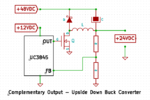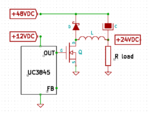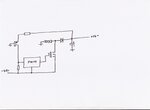kathmandu
Full Member level 5
Hello,
I need to build a non-isolated 48VDC to 24VDC (50W) converter. As I don't have much time available for a more advanced topology, I was thinking of the classical buck converter.
I already have some UC3845 (PWM controllers) available so I've decided to use one of them.
The standard buck topology needs a high-side driver (bootstrap or gate transformer) to drive the Mosfet thus I was trying to avoid that.
The usual solution is to use an upside down buck topology (aka "floating buck") to drive the n-channel Mosfet directly. The downside of this circuit is that floating output voltage (referenced to +Vcc).
Well, what if I'll connect the voltage feedback network referenced to ground, like in the schematics bellow?

I could even use a current sense resistor (ground referenced) for the Mosfet overcurrent protection.
Actually, the "genuine" output voltage will be variable (depending on Vin and the load current) thus keeping the Vin-Vout constant (the intended output voltage referenced to ground).
Is there a problem with a modified topology like this?
- - - Updated - - -
I already found a "bug": the feedback voltage must be inverted (maybe I could use a simple bjt for that).
I need to build a non-isolated 48VDC to 24VDC (50W) converter. As I don't have much time available for a more advanced topology, I was thinking of the classical buck converter.
I already have some UC3845 (PWM controllers) available so I've decided to use one of them.
The standard buck topology needs a high-side driver (bootstrap or gate transformer) to drive the Mosfet thus I was trying to avoid that.
The usual solution is to use an upside down buck topology (aka "floating buck") to drive the n-channel Mosfet directly. The downside of this circuit is that floating output voltage (referenced to +Vcc).
Well, what if I'll connect the voltage feedback network referenced to ground, like in the schematics bellow?

I could even use a current sense resistor (ground referenced) for the Mosfet overcurrent protection.
Actually, the "genuine" output voltage will be variable (depending on Vin and the load current) thus keeping the Vin-Vout constant (the intended output voltage referenced to ground).
Is there a problem with a modified topology like this?
- - - Updated - - -
I already found a "bug": the feedback voltage must be inverted (maybe I could use a simple bjt for that).



